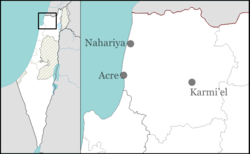Hosen
Hosen
חֹסֶן | |
|---|---|
 | |
| Coordinates: 32°59′54″N 35°17′51″E / 32.99833°N 35.29750°E | |
| Country | Israel |
| District | Northern |
| Council | Ma'ale Yosef |
| Affiliation | Mishkei Herut Beitar |
| Founded | 1949 |
| Founded by | Herut members |
| Population (2022)[1] | 1,193 |
Hosen (Hebrew: חֹסֶן, חוסן, lit. 'Strength') is a moshav in northern Israel. Located near Ma'alot-Tarshiha, it falls under the jurisdiction of Ma'ale Yosef Regional Council. In 2022 it had a population of 1,193.[1]
History
[edit]Before the Nakba, the Palestinian village of Suhmata stood two thousand feet north of Hosen's modern borders. The village of Suhmata was perched on the peaks of two hills, offering views of the lower lands on all sides except to the north. It was positioned along a highway that linked it to Safad, the coastal town of Nahariyya, and several other villages. Suhmata had a Christian community at least until the Persian invasion of Palestine (A.D. 614–627), and it is likely that many residents remained Christian for some time afterward. During the Crusades, a castle was constructed there, and the Crusaders called the site Samueth. In the latter half of the eighteenth century, Zahir al-Umar, who briefly ruled northern Palestine, undertook repairs to some of the damage caused during the Crusades. By the late nineteenth century, Suhmata had developed into a stone-built village, located on a ridge and hillside. The population at that time, around 400 people, cultivated fig and olive trees.
In modern times, Suhmata's population included 1,130 Muslims and 70 Christians. The stone houses of the village were complemented by an elementary school, founded by the Ottomans in 1886, and an agricultural school established during the Mandate period. There was also a mosque, a church, and the villagers sourced drinking water from five springs as well as domestic wells that collected rainwater. Two rain-fed pools, one holding approximately 5,000 cubic meters of water and the other half that size, were used for irrigation, with the larger pool located between the village’s two hills.
Over 70 percent of Suhmata’s land was rocky and uncultivated, dominated by oak and wild pear trees. The arable land was dedicated to growing wheat, barley, maize, tobacco, and vegetables, with the village's tobacco being particularly well-regarded. In 1944/45, 3,290 dunums were used for cereals, and 1,901 dunums were either irrigated or planted with orchards.
In 1932, an excavation near the village uncovered a Byzantine church on a nearby hill, with a mosaic inscription dating the building to A.D. 555. Additionally, Khirbat al-Duwayr and Khirbat al-Balu' were located close to the village.[2][3]

The Nakba
[edit]By the time of the Nakba in 1948, 288 Suhmata had a population of 1,311, 100% of whom were Palestinian. In October 1948 during Operation Hiram, the Golani Brigade's First Battalion assaulted and occupied Suhmata. Suhmata's population was then killed or expelled by the Israeli forces.[2][4]
Establishment of Hosen
[edit]Hosen was established in 1949 by members of the Herut political party.[3] Once settlers began arriving, Israeli army engineers blew up the remaining houses in Suhmata. The people of Suhmata were never again allowed to return to their village.[4]

References
[edit]- ^ a b "Regional Statistics". Israel Central Bureau of Statistics. Retrieved 21 March 2024.
- ^ a b "Welcome To Suhmata". Palestine Remembered.
- ^ a b Khalidi, W. (1992). All That Remains: The Palestinian Villages Occupied and Depopulated by Israel in 1948. Washington D.C.: Institute for Palestine Studies. p. 30. ISBN 0-88728-224-5.
- ^ a b Mast, Edward (Fall 2000). "Sahmatah: Awakening History" (PDF). The Drama Review. 44: 113–130.


